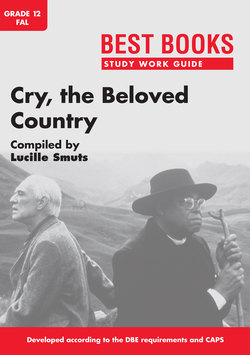Читать книгу Best Books Study Work Guide: Cry, the Beloved Country - Lucille Smuts - Страница 18
На сайте Литреса книга снята с продажи.
3.6 Conflict
Оглавление3.6.1 Internal conflict of man against self
When you are in two minds about whether you should do something or not, or when you are afraid of doing something but you really want to do it, you are experiencing conflicting thoughts and feelings. You are experiencing conflict. When this battle between opposing forces is happening inside you, you are experiencing internal conflict.
When Reverend Kumalo unexpectedly meets James Jarvis, who doesn’t recognise him at first, he experiences internal conflict. He struggles between his fear of telling James Jarvis that it was his son who killed Arthur Jarvis and his desire to tell the truth. This conflict brings tension and keeps the reader in suspense: “Will Reverend Kumalo overcome his fear and tell James or not?”
3.6.2 External conflict of man against man
Conflict can also happen between you and someone else because your opinion differs from theirs. You could have a battle of words or you could fight physically. In Book Two, Chapter Twelve, Reverend Kumalo’s opinion about his nephew’s involvement in the robbery and murder of Arthur Jarvis differs from his brother’s opinion. Reverend Kumalo believes that Absalom’s friends participated in the robbery. He accuses them of having betrayed Absalom. Furiously, John Kumalo throws his brother out of his shop: “He kicked over the table in front of him, and came at Kumalo, so that the old man had to step out of the door into the street, and the door shut against him, and he could hear the key turned and the bolt shot home in his brother’s anger” (pp. 182–183 in your school edition).
3.6.3 Man against nature
You could also be struggling against the consequences of a severe drought, when water restrictions are imposed, or when water becomes unavailable and you have to fetch supplies from a neighbouring town. The struggle of the community in Ndotsheni against nature, against erosion and drought is one of the main sources of conflict that drives the action in the novel. In Book Three, Chapter One, Reverend Kumalo hears from his friend that the community desperately needs rain because the little stream in the valley has dried up a month previously. The women have to fetch water from the river that flows from Jarvis’ farm. His friend expresses the tension that arises from their struggle for survival against the drought: “It is dry here, umfundisi. We cry for rain”; “Our mealies are nearly finished, umfundisi. It is known to Tixo alone what we shall eat” (p. 190 in your school edition).
3.6.4 Man against society
Cry, the Beloved Country is a social protest novel; it is a plea for compassion to restore social justice. It explores tensions caused by white and black people’s conflicting opinions about how to manage change from the old to the new in the developing country of South Africa with its rich resources.
It explores conflict between the old traditions and customs and the new ways of living and behaving; between moral values and the consequences of moral decay in rural and in urban society; between white and black people; between conservative and liberal white people; between corrupted and upright black people.
3.6.5 Conflict on a larger scale
Conflict in Cry, the Beloved Country is not limited to the story of Reverend Kumalo, his family and the community of Ndotsheni; nor to James Jarvis, his family and the white farming community of the Ixopo District. It is explored in the broader society of Johannesburg. How does one deal justly with the consequences of moral decay; with greed, exploitation, racial tensions, crime, delinquent youths, pregnant daughters, liquor sellers and businessmen?
How does Paton paint this bigger picture of conflicting opinions and social injustice in the Johannesburg of 1946 brought about by the discovery of gold? He uses snatches of conversation from white people to voice their fear of black crime and their differing opinions about how to deal with it in Book One, Chapter Twelve. These conversations follow the Evening Star report of Arthur Jarvis’ murder, of which black criminals are suspected. It becomes evident that their conflicting opinions provide no solutions to the problem of a crime-ridden Johannesburg: “There are voices crying what must be done, a hundred, a thousand voices. But what do they help if one seeks for counsel, for one cries this, and one cries that, and another cries something that is neither this nor that” (p. 65 in your school edition).
